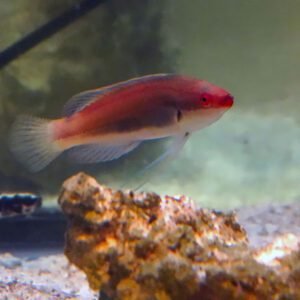Description
Scientific Name: Chaetodon flavirostris
Common Names: Black Butterflyfish, Dusky Butterflyfish, Orange-nosed Butterflyfish
Maximum Length: 8 inches (20 cm)
Minimum Aquarium Size: 75 gallons (284 liters)
Foods and Feeding Habits: Omnivorous; feeds on coral polyps, benthic invertebrates, and algae in the wild. In aquariums, offer live zooplankton, frozen mysis shrimp, finely chopped seafood, or algae-based flakes with spirulina. Feed small amounts 2-3 times daily. May initially refuse food, requiring live foods or algae-rich rock to encourage feeding.
Reef Safety: Not reef-safe; known to nip at coral polyps and small invertebrates, making it unsuitable for most reef tanks. Best kept in fish-only setups.
Temperament: Peaceful to semi-aggressive; generally ignores other fish but may show aggression toward conspecifics or similar butterflyfish unless paired. Best housed with peaceful tankmates of similar size and temperament in a spacious tank.
Description: The Chaetodon flavirostris captivates hobbyists with its bold, dark elegance and striking features, though it’s a challenge best suited for experienced aquarists. Its deep blackish-gray body, framed by vibrant yellow fins and a bright orange snout, creates a dramatic contrast that commands attention in any aquarium. Hobbyists are drawn to its graceful swimming and curious nature, often seen exploring algae-covered rocks or pairing closely with a mate, reflecting its natural behavior. A 75-gallon tank with ample live rock and open swimming space provides the ideal environment, while a varied diet of meaty and algae-based foods supports its health. Its tendency to nibble corals makes it a fish-only tank star, but its beauty and unique presence reward dedicated keepers who can meet its demanding care needs.
Fun Facts
- The Black Butterflyfish’s bright orange snout, often called “orange-nosed,” helps it stand out against its dark body, especially in dim reef lighting.
- In the wild, it often pairs for life, swimming side-by-side with its mate in a rare display of monogamy among fish.
- Its forehead hump, more pronounced in adults, adds a distinctive silhouette that sets it apart from other butterflyfish.




